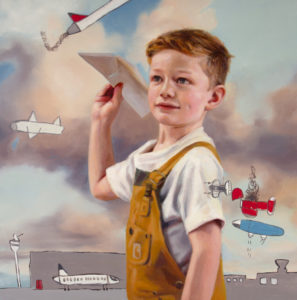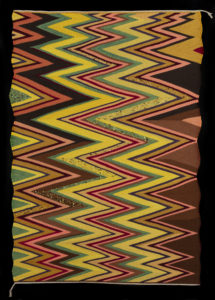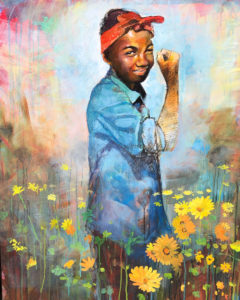
Meet the artists behind the exhibition, The Red Clay Survey: 2020 Exhibition of Contemporary Southern Art. Each week we will be featuring five of the artists included in this year’s exhibition. A major recurring regional competition sponsored by the Huntsville Museum of Art , the Red Clay Survey “takes the pulse” of contemporary Southern art through a selection of work in all styles and media. This year’s exhibition includes 85 works by 67 different artists.
Jessica Lewis
Nashville, TN

Dreams Take Flight, 2020 oil on canvas, 16 x 16 in.
It wasn’t until I became a mother that my work shifted into new territory. What began as a way to commemorate and preserve my young children’s memories soon blossomed into a reflection of not only their experiences but also my own. As they discovered the world, I began to remember things I’d long forgotten—and from a perspective I’d outgrown.
The fort building.
The make-believe.
The alternate realities.
The newness.
The strangeness.
The absolute curiosity.
The magic.
As a child, I blew smoke from my bubble gum cigarettes and hung lucky rabbit foot keychains on my belt loops. Wave pools felt like vast oceans, and I soon realized with great sadness that The Three little Pigs and bacon were the same thing.
Now, so many years later, I’m on the outside looking in…creating work that reflects their childhood, mine and ours.
I watch them grow, losing teeth and sprouting new ones that look too large for their tiny mouths. Their once plump bodies that grow sharp and gangly. My daughter’s pastel room. My son’s special knack for creating guns out of anything. Their ability to become astronauts, explorers, and kitty cats. Their wonder about the homeless man on the corner. Their questions about dying. Their small bodies and eager faces that become an explosion of unguarded joy when they’re happy—and a puddle of misery when they aren’t.
Will they remember these things? Will I?
My work is an attempt to answer that question. I paint to preserve what I know is fleeting and what I’ll want to remember: the enchanted business of childhood.
Connie Lippert
Seneca, SC

Frack, 2019
fiber, natural dyes, 58 x 40 in.
Artist Statement:
My tapestries are woven in wedge weave using yarns hand-dyed with natural materials.
Wedge weave is a tapestry weave originated by the Navajo around 1870 and practiced by them for two or three decades. In contrast to most weaving which is woven horizontally on the loom, wedge weave is woven on the diagonal which gives it its characteristic scalloped edge. This trait, which I find intriguing, is thought to be one of the reasons the Navajo abandoned it.
The colors in my palette are created with natural dyes – mainly indigo, madder, goldenrod, cochineal, and black walnut. As a result, I have become aware of the rich local history of indigo, once considered blue gold in the state of South Carolina, where I live. All my yarns are hand-dyed using indigo leaves from my garden, goldenrod gathered in the fall, black walnut hulls from a friend’s tree, and other commercially available natural dyes.
My work celebrates nature and the spirit that reveres the natural world. My message is one of environmental respect and protection.
Jerry Lynn
Arlington, TN

Her Will, 2020
acrylic on canvas, 40 x 30 in.
Jerry was born and raised in the suburbs of Memphis, Tennessee. He received early success and recognition with the collaborative art he created with his brother under the moniker “Twin”. His art is in the collections of celebrities, business leaders, and notable people such as Bob Johnson, Kem, Alonzo Morning and Isaiah Thomas to name a few. His current practice involves taking black figures from the past and present and immortalizing them on canvas in an refreshing way. His art was recently selected for the upcoming exhibit “Red Clay Suvey” at the Huntsville Musuem of Art, Alabama.
Barbara Mann
Watkinsville, GA

Long-Term Carbon Cycle Necklace, 2020 sterling silver, 22K, 14K gold, jet, rutilated quartz, smithsonite, aquamarine, diamond, peridot, 3 x 16 x .5 in.
Barbara Mann has had over 40 years’ experience as a metal and jewelry artist. She graduated from The University of Georgia with BFA and MFA degrees. She has taught for many years as an adjunct instructor at the UGA Lamar Dodd School of Art, with the UGA Studies Abroad Program in Cortona, Italy and in Costa Rica, through the UGA Continuing Education program, Arrowmont School of Arts and Crafts, and has conducted numerous workshops throughout the Southeast.
Gregory Martin
Mississippi State, MS

Oil & Water, 2018 oil on canvas, 38 x 46 in.
A native of Southern California, Gregory’s work is in many private, institutional and corporate art collections. He studied visual art at CSU Long Beach and Claremont Graduate University where he received his MFA in Painting in 2002. He’s currently an Assistant Professor in the Department of Art at Mississippi State University in a state whose name he learned to spell at an early age.
Raised in an idyllic pre-fab California suburb that on the surface looked to be the post-war American dream but in realty included such events as a boy from his scout troop murdering his family with his boy scout hatchet, One of the first famous school shootings which inspired the Boomtown Rats I Don’t Like Mondays, and interesting next door neighbors, a made-man in the mob on one side and an FBI agent on the other. He developed a heightened appreciation for the relationship between Ideal appearances and hidden realities.
His parents were both farm raised with an appreciation for nature and open spaces, always situating the family in houses on the edge of development and nature. Family vacations included farm visits and exploring natural wonders. As an adult he has spent much of his time outdoors exploring the diverse landscapes of the American west. Ever present is the development and commerce shaping the land and the marketing of it as a commodity through presenting it as a utopian dream. The history is both fascinating and tragic.
Gregory Martin’s artwork explores the relationship between human ideals and practice. Utilizing traditions such as the ideal presentations of nature and humans in landscapes, natural history displays and decorative arts he explores these as models of representation to explore our relationship with our environment and ultimately our ideals in paintings, decorative objects and dioramic installations.

